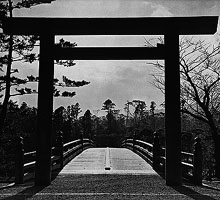
|
Enter the Grand Shrine of Ise |
The "Grand Shrine of Ise" (Ise Daijingû) is perhaps the supreme example of the relation between religion and politics in ancient Japan. In fact, as the word that was used to denote politics, "matsurigoto" ("the business of worship"), indicates, there was little distinguishing the two.
Located about fifty miles east of the Yamato region, Ise Shrine consists of two shrine complexes. The Inner Shrine (Naikû) of the Ise Shrine complex is dedicated to the sun goddess Amaterasu, the mythical ancestor of the imperial line, while the Outer Shrine (Gekû) is dedicated to Toyouke, a god of harvests. Since the 690's, both shrines have been regularly rebuilt (with some exceptions) every 20 years at an adjacent alternate site in a ritual shrine renewal (shikinen sengû) of political and symbolic meanings.
The date of the founding of the shrines is unknown; at the earliest, the Inner Shrine complex was founded in the fourth century and the Outer Shrine complex perhaps a century later. It was not until the late seventh century, when the practice of shikinen sengû began, that Ise Shrine took its present shape. Through this rebuilding, Ise Shrine thus remains the world's newest ancient monument and is still the focus of imperial harvest rites, pilgrimages, and commercial tourism.
Given the highly sacred and political nature of the shrine, up-close tours of the inner buildings are generally off-limits to the public, but thanks to WWW technology and a specially authorized study of Ise Shrine put together in1960 by famed architect Tange Kenzo, architectural critic Kawazoe Noboru, and photographer Watanabe Yoshio (published in English in 1965 by MIT Press as Ise: Prototype of Japanese Architecture), you will take in this Engaging Vision a Virtual Tour of the surrounding compound and Main Sanctuary of the Inner Shrine where the sun goddess is housed.
Instructions
Engaging Vision #1 is closely tied to Engaging Act #1. It consists of a Virtual Tour of the Inner Shrine (Naikû) complex of Ise composed of photos that are organized for viewing via maps of the compound and via a "slide show" sequence that takes you all the way from the front gate to the Main Sanctuary.
The goal of the Tour is threefold:
To bring to you in an interactive fashion a tangible sense of ancient Japanese religion, politics, architecture, and aesthetics.
To engage through this visual medium your thinking about the relation between culture and politics in ancient Japan.
To provide a complementary component to the myths presented in the Kojiki and Nihongi for our in-class discussion.
First, read the short essay "Eternal Change at the Grand Shrine of Ise" by Florian Coulmas. It will enhance your understanding and appreciation of the Virtual Tour.
Then, enter the Virtual Tour by clicking on the torii icon below. You will be presented with a First Map of items 1-12 of the Inner Shrine complex. To view the items in Slide Mode, simply click the grey righthand arrows; they will automatically take you from slide 1 to 12, and then from slide 12 to 34. The lefthand arrows will take you back. You can also view any particular item in Map Mode by clicking on its numbered red triangle, which points in the approximate direction of the view offered. You can switch modes at any time.
Slide 12 leads you to a detailed Second Map of items 13-30 of the Inner Precinct and Alternate Site. You can also access the Second Map by clicking on the "Inner Precinct" area of the First Map. Clicking on the Main Sanctuary of the Second Map will present you with architectural drawings of the Main Sanctuary for viewing further details.
The slides are accompanied by captions and in some cases explanations of particular keyword items. Red underlined text indicates further explanations of these items when clicked. There are also several questions about aspects of the Shrine to which you should formulate responses for use in your Engaging Act #1 and/or classroom discussion.

|
Enter the Grand Shrine of Ise |